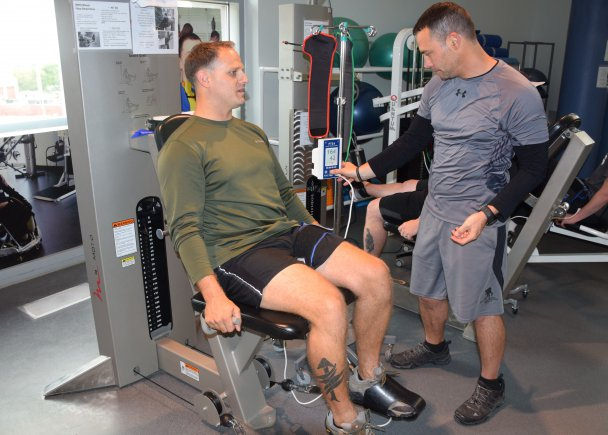BLOOD FLOW RESTRICTION AND PHYSICAL THERAPY

Tid Bits of Info
- BRT has been shown to develop strength gains when using as little as 30% of the patient’s 1RPM.
- Traditional training methods require a minimum of 70% of the patient’s 1RPM.
- BRT training utilizes low resistance and high repetitions.
- Traditional training methods utilize high resistance and low repetitions.
- The use of BRT is not common in Physical Therapy at this time, but it shows promise.
Increasing strength is one key part of an overall recovery process. Physical Therapists regularly work with soldiers, athletes and other people who need to strengthen atrophied muscles. Weak and injured muscles can slow down the rehabilitation process. As a part of our commitment to utilize the best science-based solutions, some Physical Therapists have begun incorporating blood flow restriction training or BRT to a help these weakened muscles improve strength.
Traditional strength training methods require a person to exercise with an excessively heavy resistance for few repetitions and the desired result is a muscle adaptation of hypertrophy or getting bigger. In theory, if the muscle’s cross sectional area increases due to a larger muscle cells or number of cells (that is a discussion for another time) that muscle will be stronger. The hypertrophied muscle will be able to generate more force and produce more power output. The problem arises if the patient cannot utilize a heavy resistance due to the status of their body part or other complicating factors.
The use of blood flow restriction training or BRT has gained some traction in the US in the past several years due to its apparent success of developing muscle growth, hypertrophy, while using low resistances. The exact mechanism by which it works is still unknown, but some of the early concerns of causing unrelated blood flow conditions such as deep vein thromboses have been put to rest. It appears that the blood flow can be restricted (not totally stopped) for a brief period of time and a positive hypertrophy result will occur.
BRT is not an exact science and is not currently utilized in excess during traditional rehabilitation or training sessions. One theory of how it might work states that the decrease in blood flow during exercise can lead to a hypoxic state (decreased oxygen) and force the muscle to recruit and use the fast twitch (type 2) muscle fibers which produce high power output and strength. These fibers are normally recruited and utilized by a muscle when the muscle is burning stored energy fuel (glycogen) and not relying on oxygen for its fuel source. High intensity exercise such as resistance training with heavy loads has been the standard way to recruit and develop these muscle fibers. Recently, researchers and some healthcare providers have utilized the BRT to get similar results. The major difference in training principles of the BRT vs standard is that BRT uses low loads and high repetitions to get the desired results.
The use of BRT shows promise in rehabilitation and many Physical Therapists will most likely incorporate it into their treatment protocols in the future. The use of low loads makes it possible for almost anyone with any condition to be able to perform the exercise routine and develop a larger, stronger muscle mass. Patients that have arthritic joints, severe weakness due to disease or age will be able to develop strength but spare the joint structures from further damage. The use of heavy resistance is not an option in some of the patient populations because they are too frail and weak to move this type of resistance, but can handle the low loads that are associated with BRT.
Physical Therapists are always trying to devise treatment plans designed to increase the strength of their patients. Any protocol that will enhance strength and protect the joint and surrounding soft tissue will be utilized as it researched and proven to be effective. The major issue with BRT at this time is a lack of definitive understanding of the mechanism by which this treatment works. There are no specific protocols or guidelines that are utilized for BRT, but some have proposed an 80% occlusion of blood flow and have the patient perform up to 4 sets of 15 repetitions. Some studies have shown a gain in strength using a resistance that is as low as 30% of the patient’s 1 repetition maximum (RPM). This compares to using a minimum of 70% 1 RPM in traditional training methods to get a strength gain.
BRT shows promise in helping many populations gain strength without jeopardizing other structures that might be put in harm’s way when utilizing traditional training methods. Much more research has to be performed on this type of training to determine why and how it works. The research has to determine the protocols that will enhance a patient’s strength and be a guideline for all healthcare practitioners to follow when incorporating BRT into their treatment regimen.

























